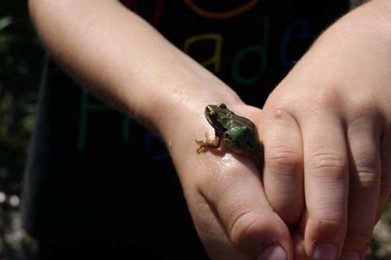
What makes a wetland work for native species in Seattle? This was the question Jasmine Baker asked when she moved to our community to continue her graduate studies with Miami University’s Project Dragonfly. She quickly gained a connection with the Woodland Park Zoo’s Amphibian Monitoring Project, where she volunteers doing monitoring at Discovery Park. However, it was hearing the Pacific tree frogs at Magnuson Park near her home and a visit to the Union Bay Natural Area that really piqued her interest. At the latter wetland she heard no tree frogs, but many bullfrogs. What was going on?
Using her own observations and sightings, which she logged into the iNaturalist community science app, she confirmed that Magnuson Park’s wetlands were teeming with the native tree frogs, while there was only one observation at Union Bay. To understand why, we must look at the wetlands themselves and their history.
The Union Bay Natural Area along Lake Union near the University of Washington is the end product of many years of habitat restoration following the lowering of Lake Washington in the early 20th century, and the use of the area as a landfill for decades. After the closure of the landfill in 1966, a series of management efforts attempted to remove invasive plants like Himalayan blackberry and purple loosestrife and return the area to a more natural state. Today, the Union Bay Natural Area is a vibrant urban ecosystem that supports many species, especially birds.
Magnuson Park had a similar transformation, this one from a Navy airfield to the multi-use park that it is today. As part of the redevelopment the City of Seattle conducted in 2008, a series of ephemeral (seasonal) ponds created a wetland complex that thrives today. Four ponds filter water from the park in a cascading pattern that provides the ideal habitat for native amphibians at various stages of their life. The wetland was created intentionally to support this ecosystem and it is doing a great job!
Union Bay Natural Area, on the other hand, is located along a lake and much of the still water in the wetlands remains all year round. This inadvertently creates an ideal habitat for the non-native bullfrog, which preys on native amphibians. The bullfrog needs two years of water for reproduction, so ephemeral ponds keep them from surviving. The same conditions make it hard for native Pacific tree frogs to thrive.
So what’s the problem, you may ask? Bullfrogs are an invasive predatory species responsible for much of the decline of many native animals. Ensuring that these amphibians do not get a foothold in intact wetland ecosystems is one way we can support our native species in Seattle.
Magnuson Park’s wetlands are not just a vibrant home for Pacific tree frogs, but for other species as well. One UW scientist has documented more dragonfly species here than in any other place in the state. And, according to E-Bird, 223 species of birds have been spotted at Magnuson Park.
Managing parklands to support native species in an urban setting is a constant challenge, but the Magnuson Park wetlands are one of the success stories you can see and hear (especially in the spring!). We hope you’ll take a stroll some day soon, and maybe even see one of our vibrant amphibian neighbors.

